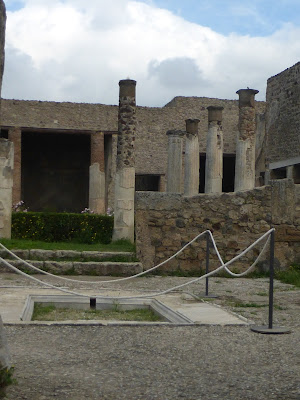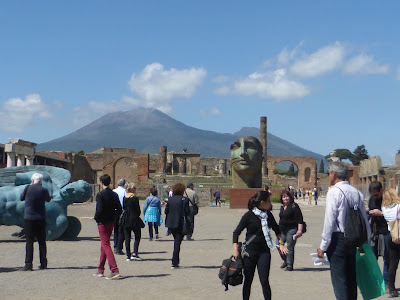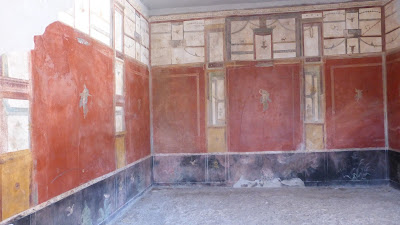 I have wanted to visit Pompeii, for so long. There was an exhibition on Pompeii, at the British Museum last year, but I missed it. So that meant only one thing, I would have travel to Italy and see it for myself. The Roman town was buried by an erupting Vesuvius in AD 79. The remians were discovered by accident in the 1590s but it was 1750 before it was seen as an archaeological treasure. Many of the works of art and everyday objects are now in the Museo Archeologico Nazionale in Naples. I will show you a few of the treasures in another post.
I have wanted to visit Pompeii, for so long. There was an exhibition on Pompeii, at the British Museum last year, but I missed it. So that meant only one thing, I would have travel to Italy and see it for myself. The Roman town was buried by an erupting Vesuvius in AD 79. The remians were discovered by accident in the 1590s but it was 1750 before it was seen as an archaeological treasure. Many of the works of art and everyday objects are now in the Museo Archeologico Nazionale in Naples. I will show you a few of the treasures in another post.
To wander around this site and walk on the same cart tracks and look in the houses as they were on that day in AD79 is hard to take in but we also have to remember that this was a place of tragedy. Overcome by the fumes there was no time to escape and the population died where they were and left us with an unparalleled view of their daily life.

The Forum was the centre of the town and was surrounded by the important government and religious buildings. (The statues are modern additions in the public area.)
Next to the Forum was the Basilica. This is where justice was administered.


Some areas were fenced off as archaeologists are still excavating. This road went right through from one side of the town to the other. You can see from these photos that there were sidewalks or pavements which were quite high for you to walk on. This was because water and waste would flow down the streets. There were also blocks in the middle of the streets to slow down the carriages to prevent the splashing of pedestrians.

This is the Lupanar. A brothel with frescoes above the doorway indicating what was on offer.There were at least three brothels in the town. The stone beds looked very small.

Close to the brothel are the Stabian Baths. They have some interesting decorations and give a good idea how baths used to function in Roman times.
Frescoes can still be seen on the walls and ceilings.
The amphitheatre is on the edge of the excavated area. Completed in 80 BC it could hold 20,000 people. It is the earliest surviving amphitheatre in Italy and one of the best preserved. It would have been used for gladiator fighting and other sports usually involving wild animals.
Opposite the amphitheatre is the Great Palaestra or Gymnasium. It is a huge enclosed area which would have held sporting activities.

On three sides of the Gymnasium there are colonnades with these bright frescoes. They are protected by glass hence all the reflections.
So much of interest as you wander along.

Known as the House of the Faun as a statue of a dancing faun was found on the site. It is a very large villa taking up an entire block. Many magnificent mosaics were found here which are now in the Archaeological Museum including the statue of the Faun.
A replica of the statue has been placed in the middle of the pool where it was found.
Many other buildings had the remains of statues, frescoes and mosaics decorating them. I can't recall the names of the buildings. here are a few of those I saw.
 |



I walked along the Via del Vesuvio to the end of the excavations and continued up to a meadow area.
I assume this may contain other parts of the town not yet excavated

It gave me a slight overview of the ruins looking towards modern Pompeii. It was the ideal spot to reflect on wh\t I had seen this day and to remember all those men. women and children who lost their lives on that fateful day in AD 79




































Been there done it and got the tee shirt twice now I must write a blog on it when I scan the photos. See you went and saw the naughty part as well then. There looks to be a couple of additions to when I went to the Forum area
ReplyDeleteohhhhhhhhhhhhhh
ReplyDeleteI wish I could have strolled along with you. The H I S T O R Y !
Great pictures! I enjoyed the tour very much, and the description of what I was seeing. Thank you! :-)
ReplyDeleteWhat an amazing place. Great photos.
ReplyDeleteWhat an amazing place to visit. This is someplace I'd love to see. Thanks for the visual tour.
ReplyDeleteThis is on my list the next time I go to Rome.
ReplyDeleteWonderful series of photographs. Bet you really enjoyed your visit there.
ReplyDeleteI would think that the size of a stone bed would be the least of its problems!
ReplyDeleteWhat a remarkable place.
Cheers - Stewart M - Melbourne
Pompeii is definitely in my list of places to visit and it was great to be able to see it through your eyes. Great post! Have you thought that it was probably due to volcano that Pompeii was protected from erosion and we are now able to admire it? Of course it would have been better if it never happened.
ReplyDeleteI've never read or seen much about Pompeii, apart from there being 'gay' frescoes being found on walls, which grabbed my attention when I was quite young. It is extraordinarily well preserved. I have a memory the standard rail gauge is based on the width of Roman cart wheels. Haha, speed humps to stop pedestrians beings splashed with putrid water, or worse.
ReplyDeleteAmazing what still has left there, it is so well preserved and so you recognizes so much things we still have now as pavements and bathrooms.
ReplyDeleteI have been several times in the South of Italy but had never time to visit Pompei. Isn't that amazing how they lived ? Nearly better than today ! While we in the north were still running around in furs !
ReplyDeleteWhat an amazing place - near the top of my bucket list. I always find photos with Vesuvius in the background eerie, knowing what happened there.
ReplyDeleteIt is great how it has been preserved. I was there in 1970 but I don't remember seeing all the stuff you have photographed. Some pics are familiar. I guess excavation has been ongoing since then too. They wouldn't let the women see the naughty frescos.
ReplyDeleteWow, that was incredible! I saw the Pompeii exhibit when it toured the US a few years ago but it was nothing compared to this! I'm putting this on my bucket list, thanks to your visit.
ReplyDeleteIn utter awe~!
ReplyDelete